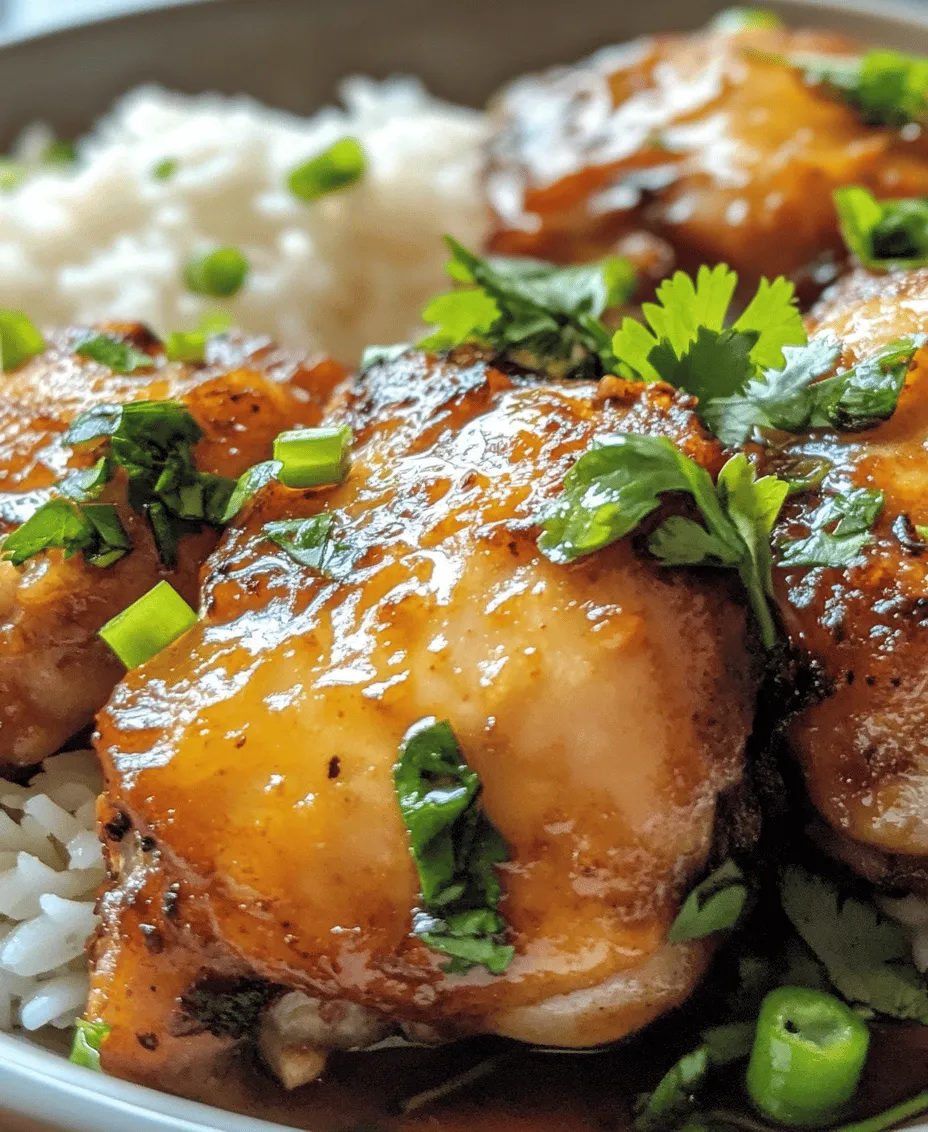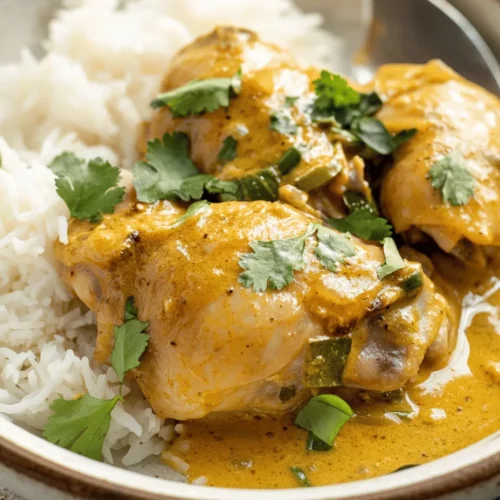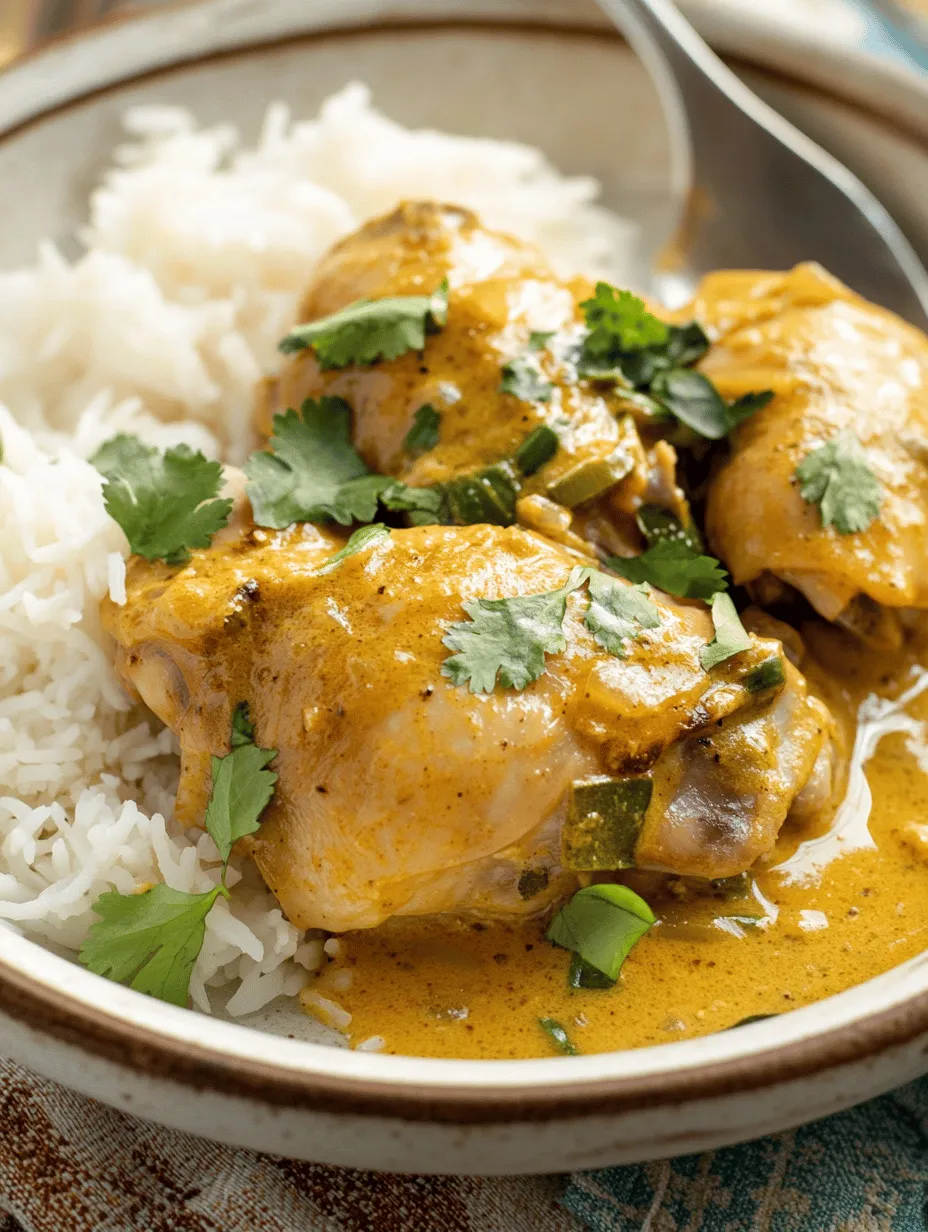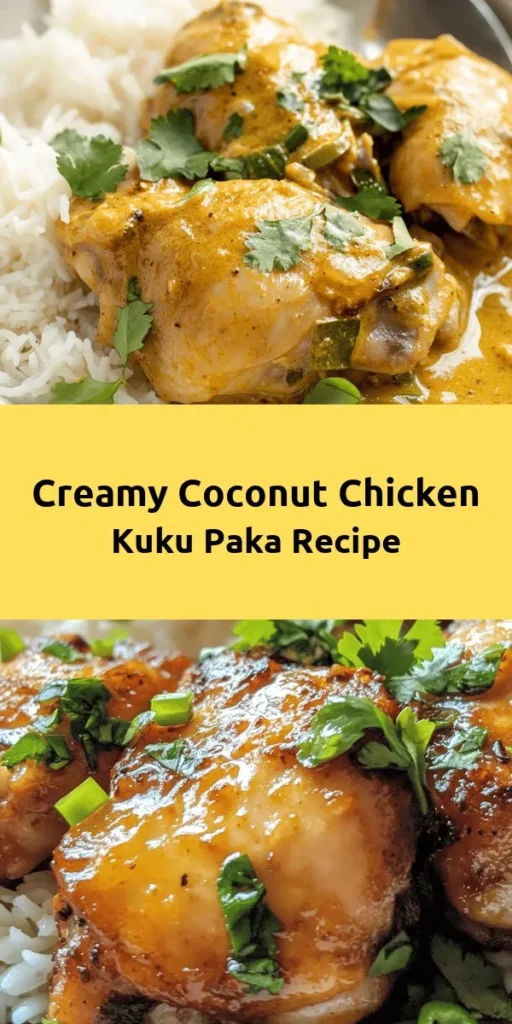Introduction
Kuku Paka is a dish that embodies the vibrant flavors and rich culinary heritage of East Africa, particularly within the Swahili culture. This delightful recipe showcases succulent chicken thighs enveloped in a luxurious, creamy coconut sauce, making it a staple in many households across the coastal regions of Kenya and Tanzania. The dish not only serves as a testament to the use of locally sourced ingredients, such as fresh coconut milk and spices, but also highlights the cultural exchange that has influenced Swahili cuisine over the centuries.
Kuku Paka is lauded for its simplicity and depth of flavor, appealing to both novice cooks and seasoned chefs alike. The straightforward preparation process allows anyone to replicate the dish in their own kitchen while still achieving an impressive presentation that can grace any dining table. With its combination of tender chicken and a rich coconut sauce, Kuku Paka is the perfect meal for family gatherings, dinner parties, or simply to enjoy a taste of East Africa at home.
Understanding Kuku Paka
The origins of Kuku Paka can be traced back to the coastal regions of East Africa, where the Swahili people have long embraced the use of coconut as a key ingredient in their culinary repertoire. The term “Kuku” means chicken in Swahili, while “Paka” translates to “to coat” or “to spread.” This name beautifully captures the essence of the dish, which features chicken bathed in a creamy coconut sauce, often served with rice or flatbreads.
Historically, Kuku Paka has evolved as a beloved dish across various regions, with each locality adding its unique twist. The influence of Indian, Arab, and Portuguese cuisines is evident in the spices and cooking methods used to prepare this dish. Coconut milk plays a crucial role in Kuku Paka, not only providing the signature creaminess that characterizes the sauce but also enhancing the overall flavor profile with its subtle sweetness. This integration of flavors and techniques showcases the rich tapestry of cultural influences that have shaped Swahili cuisine over time.
The dish has become increasingly popular beyond its traditional roots, often featured in restaurants and homes alike, as people seek to explore the diverse tastes of global cuisines. Whether enjoyed as a comforting family meal or served to impress guests, Kuku Paka is a culinary experience that encapsulates the warmth and hospitality of East African culture.
Ingredients Breakdown
To create an authentic Kuku Paka, several key ingredients play a pivotal role in achieving the dish’s signature taste and texture. Below is a detailed breakdown of these ingredients, demonstrating their importance in crafting this creamy chicken delight.
Chicken Thighs
When it comes to selecting the right cut of chicken for Kuku Paka, bone-in, skin-on chicken thighs are the preferred choice. This preference is primarily due to the richness of flavor and moisture that the thighs provide during cooking. Unlike chicken breasts, which can easily dry out, thighs remain tender and juicy, soaking up the flavors of the coconut sauce beautifully. The skin also contributes to the overall taste, rendering down during cooking to impart additional richness to the dish.
Spices and Aromatics
The complexity of Kuku Paka largely stems from the array of spices and aromatics that are used in its preparation. Key spices such as garam masala, cumin, and coriander are essential in creating the dish’s depth of flavor. Garam masala, a fragrant blend of spices, adds warmth and earthiness, while cumin lends a subtle smokiness. Coriander provides a hint of citrus that balances the richness of the coconut milk.
In addition to spices, aromatics such as onions, garlic, and ginger are instrumental in building a robust flavor base for the sauce. These ingredients release their essential oils when sautéed, infusing the dish with a savory aroma that is irresistible.
Coconut Milk
No recipe for Kuku Paka would be complete without coconut milk, which is the star of the show. This ingredient is crucial in providing the dish its creamy texture and luscious mouthfeel. The natural sweetness of coconut milk complements the spices and enhances the overall flavor profile of the dish. When simmered with the chicken and spices, the coconut milk transforms into a rich sauce that clings to the chicken, creating a comforting and satisfying meal.
Fresh Ingredients
Fresh herbs and lime juice are essential components that brighten the dish and add a burst of freshness. Commonly used herbs include cilantro or parsley, which can be sprinkled on top of the finished dish for a pop of color and flavor. Lime juice, added at the end of cooking, provides a zesty contrast to the richness of the coconut sauce, cutting through the creaminess and elevating the overall taste experience.
Preparation Steps Explained
Once you have gathered all the necessary ingredients, it’s time to dive into the preparation of Kuku Paka. The following comprehensive guide outlines each step of the cooking process, ensuring clarity and detail for a successful culinary endeavor.
Preparing the Chicken
Before cooking, it is important to season the chicken thighs well. Start by patting them dry with paper towels to remove excess moisture, which helps achieve a nice browning when searing. Season the chicken generously with salt and pepper, and allow it to rest at room temperature for about 15-20 minutes. This step not only enhances the flavor but also brings the chicken to an even temperature, promoting even cooking.
Sautéing Aromatics
In a large, heavy-bottomed skillet or pot, heat a couple of tablespoons of oil over medium heat. Once the oil is shimmering, add chopped onions and sauté until they become translucent and fragrant, which usually takes about 5 minutes. Then, introduce minced garlic and ginger to the pan, stirring for an additional 1-2 minutes. This combination of aromatics forms the backbone of the Kuku Paka sauce, creating a flavorful base that will elevate the dish.
Incorporating Spices
With the aromatics beautifully sautéed, it’s time to add the spices. Sprinkle in the garam masala, cumin, and coriander, toasting them in the pan for about 30 seconds. This technique of toasting spices helps release their essential oils, intensifying their flavor and aroma. Be sure to stir continuously to prevent the spices from burning, as burnt spices can impart a bitter taste to the dish.
Browning the Chicken
After the spices are fragrant, it’s time to brown the seasoned chicken thighs. Increase the heat to medium-high and place the chicken thighs skin-side down in the skillet. Allow them to sear without moving them for about 5-7 minutes, or until the skin is golden brown and crispy. This browning process not only enhances the flavor but also adds visual appeal to the final dish. Once browned, flip the chicken thighs and cook for an additional 5 minutes on the other side.
Simmering
Once the chicken is browned, it’s time to add the coconut milk to create the sauce. Pour in the coconut milk, scraping the bottom of the pan to release any flavorful bits stuck to it. Bring the mixture to a gentle simmer, then reduce the heat to low and cover the skillet. Let the chicken simmer for 30-40 minutes, until it is cooked through and tender. This gentle cooking process allows the flavors to meld beautifully, resulting in a creamy sauce that envelops the chicken.
As the chicken simmers, take the opportunity to prepare any sides, such as rice or flatbreads, that will complement this delightful dish. The combination of Kuku Paka with a simple side will ensure a satisfying meal that showcases the rich flavors of East African cuisine.
With each of these steps, you are on your way to creating a delicious Kuku Paka that is sure to impress family and friends alike. The balance of spices, the creaminess of the coconut milk, and the tenderness of the chicken come together to form a dish that is both comforting and exotic, making it a wonderful addition to any mealtime repertoire.

Serving Suggestions
Kuku Paka is a flavorful dish that deserves to be complemented with equally delightful sides. When planning your meal, consider the following options to create a balanced and satisfying experience:
– Rice Options: The right rice can elevate the entire meal. Basmati rice, known for its fragrant aroma and fluffy texture, pairs wonderfully with the creamy coconut sauce of Kuku Paka. Its nutty flavor complements the spices in the dish without overpowering them. Alternatively, jasmine rice, with its slightly sweet aroma and stickiness, offers a lovely contrast to the savory chicken. Both rice options can absorb the delicious sauce, making every bite a treat.
– Flatbreads: Flatbreads like chapati or naan are excellent accompaniments for Kuku Paka. These breads are perfect for scooping up the rich sauce and tender chicken, providing a delightful textural contrast. Chapati, made from whole wheat flour, adds a wholesome element to the meal, while naan, often enriched with yogurt, is soft and buttery, enhancing the overall indulgence.
– Garnishing: A finishing touch of fresh coriander leaves not only adds a pop of color but also infuses a burst of freshness to the dish. The vibrant green coriander complements the rich, creamy sauce, creating a visual appeal that entices the palate. Consider adding a sprinkle of lime juice over the finished dish for an extra layer of brightness.
Nutritional Information
Kuku Paka isn’t just a treat for the taste buds; it also packs a nutritional punch. Here’s a look at some of the health benefits that this dish offers:
– Protein Content of Chicken: Chicken is an excellent source of high-quality protein, essential for muscle growth and repair. It provides the body with the necessary amino acids, making Kuku Paka a filling and nutritious meal option. Depending on your choice of chicken parts—be it thighs or breasts—you can also control the fat content to suit your dietary needs.
– Health Benefits of Coconut Milk: Coconut milk, a key ingredient in Kuku Paka, is rich in healthy fats, particularly medium-chain triglycerides (MCTs), which are known to provide quick energy. Additionally, coconut milk contains vitamins C and E, which are beneficial for skin health and immune function. It also has anti-inflammatory properties, making it a great addition to any diet.
– Spices and Their Benefits: The spices used in Kuku Paka, such as turmeric and cumin, are not just there for flavor; they also offer various health benefits. Turmeric is well-regarded for its anti-inflammatory and antioxidant properties, while cumin aids in digestion and boosts immunity. Together, these spices create a dish that is not only delicious but also nourishing.
When combined, the protein from the chicken, the healthy fats from the coconut milk, and the diverse vitamins and minerals from the spices create a well-rounded meal that satisfies both the palate and the body.
Culinary Tips for Perfect Kuku Paka
To ensure your Kuku Paka turns out perfectly every time, consider the following culinary tips:
– Adjusting Spice Levels: One of the beautiful aspects of Kuku Paka is its adaptability. If you prefer a milder dish, reduce the number of green chilies or remove the seeds to lessen the heat. Conversely, if you enjoy a spicy kick, feel free to add extra chilies or even a pinch of cayenne pepper to your coconut sauce. Tasting as you cook is key to achieving your desired flavor profile.
– Substitutions: While the traditional recipe calls for bone-in chicken for rich flavor, boneless chicken can be used for convenience and quicker cooking. Additionally, if you don’t have chicken broth on hand, vegetable broth can be a suitable alternative, though it may slightly alter the flavor. For those looking to make a vegetarian version, tofu or chickpeas can be great substitutes for chicken, absorbing the flavors of the coconut sauce beautifully.
– Sautéing Techniques: To enhance the flavor base of your Kuku Paka, consider sautéing the onions until they are golden brown before adding the spices. This caramelization adds depth to the dish, enhancing its overall complexity.
Storing and Reheating Kuku Paka
If you find yourself with leftovers (which is often the case with this delicious dish), proper storage and reheating will ensure that Kuku Paka retains its delightful flavors and textures:
– Storing Leftovers: Allow your Kuku Paka to cool to room temperature before transferring it to an airtight container. It can be stored in the refrigerator for up to three days. For longer storage, consider freezing the dish in a freezer-safe container, where it can last for up to three months. When freezing, portion out the servings to make reheating easier.
– Reheating Methods: For the best results, reheat Kuku Paka gently on the stovetop over low heat, stirring occasionally to prevent sticking and ensure even heating. If the sauce thickens too much during storage, add a splash of coconut milk or broth to loosen it. Alternatively, you can reheat individual portions in the microwave, covered, for a quick and convenient meal. Be sure to stir halfway through heating to ensure even distribution of warmth.
Conclusion
Kuku Paka is more than just a chicken dish; it is a celebration of flavors, textures, and cultural heritage. The combination of tender chicken simmered in a creamy coconut sauce, infused with aromatic spices, creates a meal that is both comforting and exotic. Whether served over fragrant basmati rice, alongside soft naan, or garnished with fresh coriander, Kuku Paka is sure to impress your family and friends.
Not only does this dish delight the palate, but it also nourishes the body with its wholesome ingredients and balanced nutritional profile. As you embark on your culinary journey to recreate Kuku Paka, take pride in the process and the joy it brings to your dining table. This recipe invites you to share the experience of a homemade meal, fostering connections and creating memories that will last a lifetime. So gather your ingredients, follow the steps, and savor the delightful experience of making and enjoying Kuku Paka.



